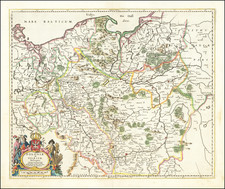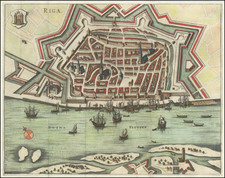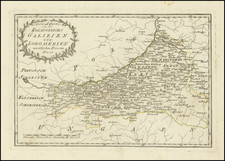Fine map of Prussia celebrating the inauguration of Frederick I in 1701 as Holy Roman Emperor. Despite keeping the title Frederick III of Brandenburg until his death in 1713, as suggested on this map, he would later be referred to as Frederick I.
This gorgeous map shows the Baltic region from the Pomeranian coastline to the modern-day Lithuanian-Latvian border, extending south to the heart of Poland. The map is centered on Dantzig (Gdansk), Konigsberg, Heilsberg, and other cities.
The magnificent ornate cartouche praises the election of the new Holy Roman Emperor. He was crowned King in Prussia out of deference to Augustus the Strong and the Polish-Lithuanian Sejm. This cartouche dates the map to the period 1701-1713 (when Frederick I was succeeded by his son Frederick II), and most likely to the first part of that range.
Johann Baptist Homann (1663-1724) was a mapmaker who founded the famous Homann Heirs publishing company. He lived his entire life in Bavaria, particularly in Nuremberg. Initially, Johann trained to become a priest before converting to Protestantism and working as a notary.
In 1702, Johann founded a publishing house that specialized in engravings. The firm flourished, becoming the leading map publisher in Germany and an important entity in the European map market. In 1715, Johann was named Imperial Geographer to the Holy Roman Empire by Charles VI and made a member of the Prussian Academy of Sciences. Most importantly for his business, his reputation and contacts gained him imperial printing privileges which protected his publications and recommended him to customers. Johann is best known for this Grosser Atlas ueber die ganze Welt, or the Grand Atlas of the World, published in 1716.
After Johann died in 1724, the business passed to his son, Christoph (1703-1730). Upon Christoph’s early death, the company passed to subsequent heirs, with the name of the company changing to Homann Erben, or Homann Heirs. The firm continued in business until 1848.













![[ Hand Drawn Map of Western Poland Centered on Lubsko]](https://storage.googleapis.com/raremaps/img/small/99033.jpg)
![[ Poland ] Poloniae Finitimarumque locorum descriptio Auctore Wencelslao Godreccio](https://storage.googleapis.com/raremaps/img/small/67482.jpg)